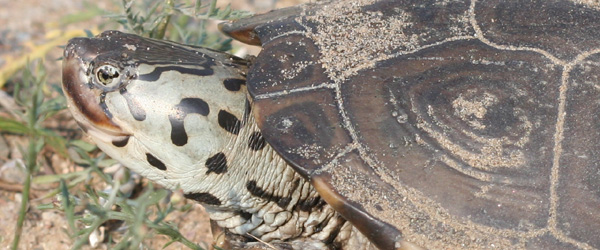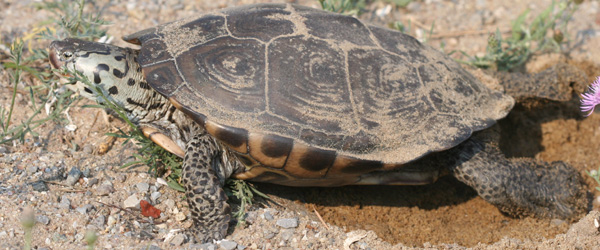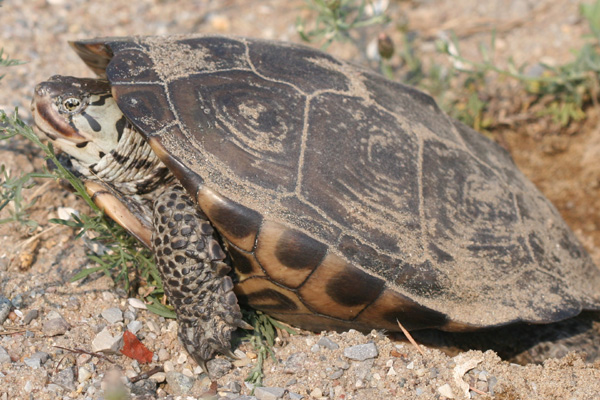In my walk around Jamaica Bay today I saw many cool birds, some neat bugs, and, best of all, a Diamondback Terrapin (Malaclemys terrapin) burying her nest. Unfortunately for her eggs, she chose to bury them right in front of a bench on the trail around the West Pond (a not uncommon occurrence at Jamaica Bay, according to this abstract). Fortunately for her eggs I marked the nest with a makeshift flag fashioned from a twig and a band aid and when I reached the visitor’s center I let the woman behind the desk know the exact location and she promised to inform their terrapin researchers.
Diamondback Terrapins are not on the federal endangered species list but they are considered endangered, threatened or “of concern” in several states. They live along the east coast of the United States from Texas to Cape Cod in brackish water, feeding on a variety of marine life, and come ashore to lay their eggs in sandy soil (often two clutches are laid in a single summer). Though at one time they were considered a delicacy people stopped eating them quite awhile ago and in most locations their populations eventually bounced back. The biggest threat to them now (except for the omnipresent habitat loss) is still predation, not by people, but by raccoons, skunks, crows, and muskrats.
At Jamaica Bay a trail off of the West Pond trail called the Terrapin Trail is closed to people this time of year to allow the terrapins time to lay their eggs in peace. But the terrapins don’t know that only a portion of the preserve is closed off, of course, so they lay their eggs wherever they find the right kind of soil, which keeps the terrapin researchers busy!
The female in these pictures was a bit smaller than the size of a dinner plate and didn’t seem to mind me watching her burying the eggs. I did not get too close, and once she was done burying her eggs she ambled off into the undergrowth, done with her parental duties.
















Maybe the refuge could enclose the nest with a little fence or rope it off so that people won’t walk on it. Of course, I’m not sure if walking over a nest will hurt the eggs.
Terrific pictures and cool story. Oh, for parental duties to end at that!
Kick butt pictures Corey! I’ve never actually seen a Terrapin in the wild. I love the pattern on their bodies.
I Went birding in jamaca bay n.y. brooklyn and its always great to go their for birding and bird watching and in the winter see all kinds of ducks any way this sunday I went birding never saw a turtle lay eggs until sunday what a beautiful sight waited till the turtle buried her eggs I am not sure I think it takes 50 days for the eggs to hatch or 45 days I hope no preditors dont eat them because I know their survival rate is very slim any way the ospreys layed theirs and had 4 babys alot of times I only see 2 or 3 but this year it was 4 and the geeses had their babys and the swans birds nature is so so beautiful its such a gift of god the beauty that we have right here in n.y I just love it any way hope to recieve an answer about the turtles how many days or months after they bury their eggs when they hatch….
When is a good time of year to go to Jamaica Bay? My 13-year old girls loved birds, turtles, bugs, animals of all kinds. Is it too early to go now? any tips much appreciated. !!
@katie: It is ahead of the usual time of year for Diamondback Terrapins but there are a horde of other good things to see any time of year.
Any of you interested in the JB terrapin story should know that JB terrapin work is done entirely by my volunteer research team and while tolerated is not supported by the National Park Service. We are out there 7 days/week in June and July monitoring nesting terps and protecting nests when we can. You can learn more about our work, and volunteer if you like, by checking out http://jbtr.org/ and/or checking our our FB group.